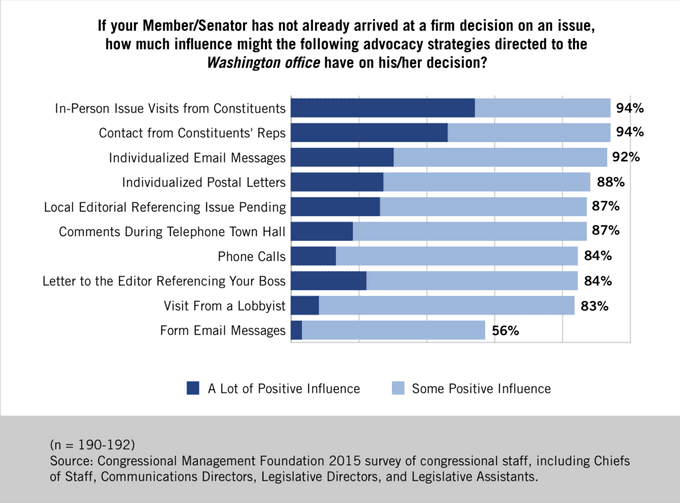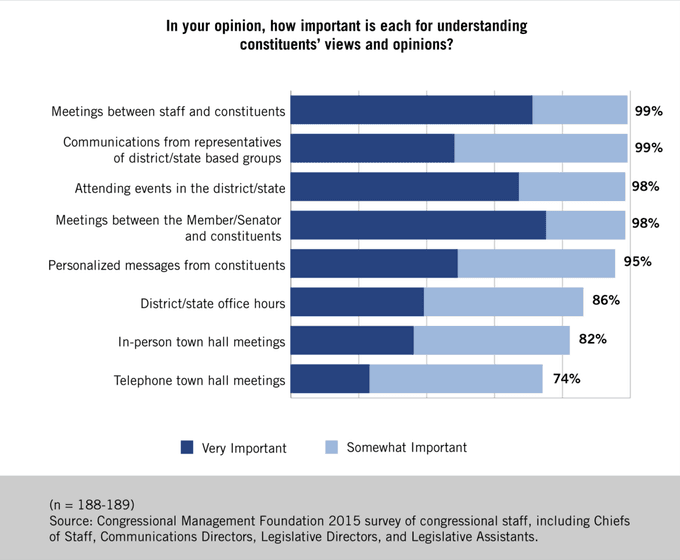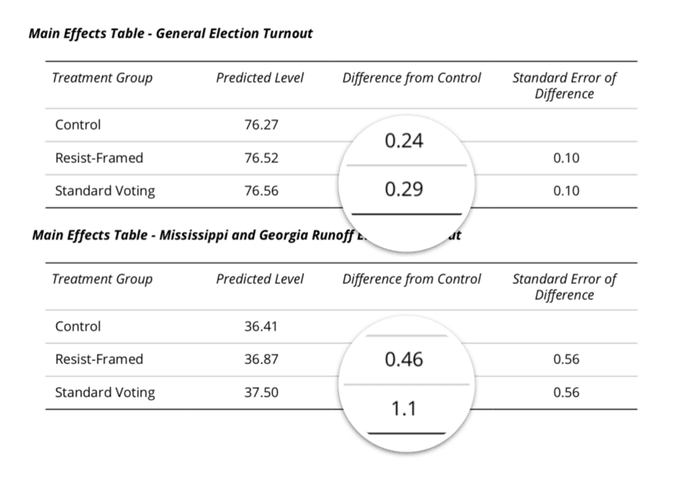Yes, Resistbot Is Effective.
Forget calls vs. letters, an independent study showed Resistbot generated over 12,000 net votes in the 2018 midterms.
by Jason Putorti

Cory Young, Tulsa World
How effective is Resistbot, really? It’s a question I’ve heard every so often, and finally something I’d like to answer with real data.
On Being Heard
Millions of people felt that they weren’t being heard, especially after the 2016 election, and far too many of them were right. A wave of citizen activism driven by Women’s March, Indivisible, and other groups drove waves upon waves of calls that never reached a Congressional office. Nonetheless, many organizers believed calls to be the only impactful action, and insisted on that being the primary instrument of resistance. However, Brad Fitch, the head of the Congress Foundation that studies how Congress operates, considers calls to be the “least robust method” of contacting Congress. And at the scale groups were driving calls to Congress, offices were paralyzed, staff overwhelmed, and many citizens shut out entirely because there weren’t enough phone lines.
Frustrated, we created another path to be heard: a text-to-fax service, and launched Resistbot in March of 2017 to a lot of excitement. We didn’t tell anyone it was the one right way, or pretend to be activists or organizers; we were simply trying to solve a problem people had, including us. It worked, so people started using it more and more. For millions, it was like opening the backdoor to Congress, and fulfilling their desperate need to be heard. They wanted to tell the government not to take their health care away, not to cripple the free and open Internet, or not to repeat the mistakes of Internment Camps in the 1940s. For them, it was gratifying to know that tangible evidence of their opinion was printing out in Congressional offices. It was also immediately evident that more people were willing to use Resistbot, having the ability to be thoughtful and formulate an argument in a few minutes from anywhere, than make a call that was often emotional and caused anxiety for many. Here’s an experiment we conducted on asking users to write or call, or just call. A and B are different ‘push alerts’ we sent to users:
A: 9,074 pushes → 1,052 letters and 45 calls (12% took action)
The FCC will soon vote to kill net neutrality. Congress can stop them, but they need to hear from you. Call 949-555-1212 or text ‘house’
B: 8,993 pushes → 180 calls (2% took action)
The FCC will soon vote to kill net neutrality. Congress can stop them, but they need to hear from you. Call 530-555-1212 to weigh in.
It’s fair to say Congressional offices had mixed opinions of this approach early on. Processing faxes took some extra time in offices on Capitol Hill and in district offices. When we passed the 1-million-pages-per-month milestone, some Congressional offices just unplugged their machines rather than deal with the fire-hose of letters. We worked with staffers to mitigate their issues, such as a design that made them easier to parse, and complete address data for users. However the sheer volume eventually became self-defeating just like calls did between Election Day and the Inauguration.
So we reinvented Resistbot because our goal is effectiveness: helping constituents actually communicate with their government. Our goal is not to overwhelm elected officials as a method of protest. The volume of communication from Resistbotters sometimes can shut down an office, but that is not and never has been the point. There’s a time and place for protest, but our goal is to get users in the habit of regular engagement — including getting replies from their officials. We hope this engagement leads to a higher voting rate. To do this, we couldn’t be and are not a protest technology. Resistbot is a communication technology to connect people to their elected representatives.
Of course, not everyone agrees that making it easier to contact your government is a good thing. There is a longstanding assumption that representation is not about what constituents feel but about how strongly they feel it. This school of thought holds that hand-written letters, lengthy phone calls, in-person visits, and large cash donations are how we should be communicating.
We couldn’t disagree with this more. This incredibly privileged point of view is inherently undemocratic, giving a louder voice to people that have a lot of time, a lot of money, or a lot of access to the people who are supposed to be working for all of us. It disadvantages many people who don’t have the time, resources, or comfort expressing themselves this way. It means politics is spoken with an upper class accent. The ideological middle also tends to disappear, further polarizing our already hyper-partisan society.
The people that need to be heard and considered by our officials may not have the time to hand-write a letter, the ability to drive to a town hall, or the money to travel and buy face-time in the halls of power. Ironically, Congressional staffers tend to complain the loudest about communications that are slow and hard to process like hand-written mail, yet bemoan tools that make things easier. The objective data we have from Congress Foundation shows the following:

From the 2017 Congress Foundation Report on Citizen-Centric Advocacy
First on that list is showing up to an office, and looking these up in Resistbot is something we’re working on. Second is contact by an intermediary like a community organizer, trade association / activist group, etc; we have done this for groups in the past who want to both make a point in person and back it up with the weight of a thousand-page stack of letters. Third is exactly what Resistbot does every day: individualized electronic messages (we’ve never done form emails).

From the 2017 Congress Foundation Report on Citizen-Centric Advocacy
So, what Congress wants to see isn’t really someone spending needless hours on hand-writing, just communication delivered based on education about the issue and individual purpose.
This is why Resistbot makes users actually write their own messages. Volume is and never has been the goal. Unlike outside advocacy groups that blast Congress with mass, pre-written e-mails that a user just has to click to send, Resistbot asks users to communicate, in their own words, what they want their government to do. The result is engaged citizens writing largely personal emails to protect the rights they have, and fight for the rights they don’t.
Given we’re currently in a governing situation that’s evolved over the last 40 years into minority rule, where policies that poll over 90% won’t pass because one party doesn’t believe the public will participate enough via the ballot box, the answer to us isn’t participation by a select few with time and resources, but more participation by more people, a lot more.
More Participation = More Votes
A Congressional staffer told us back in 2017 that, “sending a text that generates a fax isn’t on the ladder of engagement.” A prominent civic tech writer told us not to build “tech we don’t need” three weeks after launch. In 2018, a funder and activist was worried about whether we were getting millions of users to take action and drive results, or merely serving as a “pressure valve that allowed ticked off users to take a symbolic action.” In other words, were we the first rung on a ladder, or a distraction?
Well, we now know the answer to that question.
For many thousands of people, sending a message to Congress with Resistbot was their first step in their civic education and engagement. We’ve heard these stories many times. Unfortunately, citizen advocacy may not be enough to change some policies. That’s disheartening, but even if Congress ignores their constituents at their inbox, members of Congress can’t ignore their constituents at the ballot box.
That’s why, from the very beginning, we knew that everyone who wrote their officials between elections would hear back from us in the lead up to Election Day. We knew that every user who texted the bot had the potential to become a vote in every election thereafter.
In the 2017 statewide races, 2018 midterms, and in several special elections, we ran a comprehensive voter turnout program. It included early vote and election day reminders, polling lookups, voter registration, voter registration checks, voter ID information, and absentee ballot information. In addition, we helped get users into volunteer shifts, booking over 15,000; and with inviting their friends to check their polling places or voter registration. Over 4 million people heard from us leading up to the midterms. Even now we’re ensuring over 290,000 people aren’t deprived of their franchise with our voter roll monitoring technology. (Think of it like credit report monitoring, use the check keyword to sign up.)
We didn’t just assume that our hard work paid off. We wanted to prove it worked, and worked well. We’ve stared at Resistbot user logs and social media conversations for over two years. We helped a lot of people become engaged, but surely not everyone. So we had the Analyst Institute run a rigorous independent evaluation of our series of turnout messages during the 2018 midterm. They found that:
Baseline turnout was very high, at 76%; this is about 50% higher than the turnout rate predicted by subscribers’ vote propensity scores, at 51.
For reference, 49.3% of the general eligible voting population voted.

Excerpt from Analyst Institute Study of Resistbot’s 2018 voter turnout program.
More importantly, the Analyst Institute’s independent evaluation used a randomized control design among a sample of our subscribers. This study compared subscribers we tried to mobilize to a small randomly selected group of our subscribers who we didn’t send turnout messages in the 2018 election.
Resistbot’s GOTV [get out the vote] program was highly cost-effective and able to generate an impressive number of net voters, surpassing the performance of many other programs in midterm election cycles.
In total, the program generated about 3,716 net voters at a rate of 63 net voters per $1,000 spent, or $16 per net voter. This is almost three times more cost-efficient than social pressure mail, A.I.’s strongest GOTV recommendation.
A.I. only studied a sample of our user base, so extrapolating that out to the entire set of voters we ran the program on gets us over 12,000 net votes — and that’s just from our own users. It doesn’t take into account the over 15,000 volunteer shifts we filled or the tens of thousands of friends our users texted or emailed. We even registered 12,000 new voters in-bot. For perspective, five house races were decided by fewer than 4,000 votes. The 2016 Trump margin in Michigan and Wisconsin was 10,704 and 22,748 respectively.
The program had large effects on turnout in the Mississippi and Georgia runoff elections. In the runoff elections, the standard voting messages increased turnout by 1.1 percentage point.
When there are elections without as much attention our methods really shine. The study showed we produced an additional 340 net votes in the runoff elections. The effect in the run-off elections to our full set of users in those states means more than 1,000 people voted who would have otherwise not been heard at the ballot box.
In Conclusion
So when folks out there insist on only sharing the Congressional switchboard number, or think we’re a cheap version of advocacy, please point them here. Driving folks at the switchboard number will generate some calls, but too many simply won’t engage, and so now they’ve either done nothing, can’t be turned out to vote or volunteer later, or both. Every switchboard share (202-224- 3121) is a lost opportunity to get votes in 2019, 2020, and beyond. There’s nothing that motivates someone to vote quite like a dismissive letter on the fridge from a Senator telling you why he’s not going to do anything about gun safety.
And what did that activist funder have to say after that study came out? The guy who was so worried about Resistbot sapping the political energy of its users?
Of course it’s only a single test, but holy cow that’s promising. With these results, I’ve gone from a skeptic to an enthusiast about the role that Resistbot can play in your various efforts.
We’ve built a product that’s been proven to turn “slacktivism” into voting. So please, help us grow: Share Resistbot with your friends who are not (yet) engaged in politics. It’s an easy way for them to get started. Donate to keep us online. Someone who texts a 50-word letter today may show up at a protest or town hall in a month, vote in November, and drag three friends to the polls along with them.
And isn’t being heard better than a voicemail-is-full message or a busy signal?
Support the ’bot!
Upgrade to premium for AI-writing, daily front pages, a custom keyword, and tons of features for members only. Or buy one-time coins to upgrade your deliveries to fax or postal mail, or to promote campaigns you care about!
Upgrade to PremiumBuy Coins